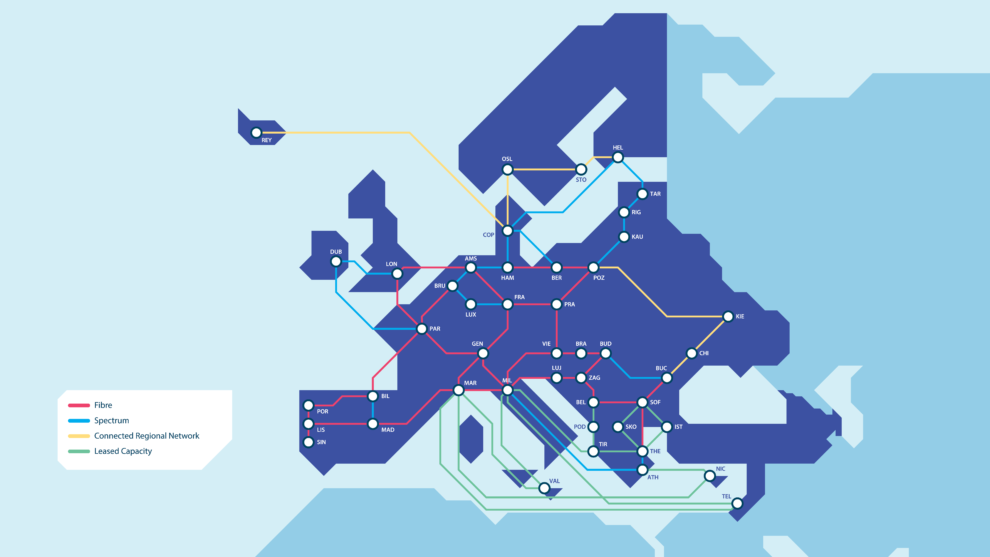The traffic on the GÉANT IP network has seen sustained long-term growth of over 30% per annum. Even with the COVID-19-related restrictions, where commercial traffic saw a dip, big science users’ traffic largely remained unchanged. The traffic on the packet layer saw a decrease of 8% in 2020 followed by an increase of 17% in 2021. Clearly, supporting this long-term growth with a policy of business (and technology) as usual would not be sustainable even in the medium term.
The GN4-3N project represents a revolution in the method of both procuring and operating the GÉANT network. The fibre network is being replaced with long-term IRU-based contracts for connectivity and the Optical Line System (OLS) is being replaced with a disaggregated OLS. The next-generation GÉANT network, launched to the GÉANT community at TNC22 in Trieste, has understandably been a long-term endeavour with planning started during the previous GN4-2 project and the project continuing until December 2023.
Rethinking Procurement
The previous GÉANT network was built using traditional networking vendor hardware and software and communication service provider infrastructure. At this time, the leased fibre for the GÉANT network was procured approximately every seven years on short-medium term leases. This placed a significant cost and implementation burden on GÉANT as services needed to be migrated frequently. This burden is being addressed through the GN4-3N project to procure fibre on long-term, 15-year contracts.
The GÉANT Fibre (and Spectrum) network will eventually triple in length to ~30,000km, connecting almost double the number of countries (at least 24, up from 14 connected pre-GN4-3N) while at the same time reducing operating costs. However, cost reduction is not the only reason for this network revolution.
Disaggregation – the new model for optical network development
At a technology level, the optical system of the GÉANT network is being replaced as a result of a detailed re-evaluation of the requirements, and an alternative approach for the transport layer infrastructure using an open OLS was implemented to ensure efficient and effective use of the fibre resources. Much of this new technology has been developed by the cloud service industries using equipment focused on data centre environments and the needs of these organisations for more focused feature sets and hardware profiles designed from the ground up for the new data centre facilities.
The disaggregation trend in optical systems has brought in significant new changes in how networks are built. GÉANT is moving to optical layer desegregation with the disaggregation of the optical layer in transponders, Data Centre Interconnects (DCIs) and line systems.
The flexibility offered by the open OLS has enabled GÉANT to build its pan-European Dense Wavelength-Division Multiplexing (DWDM) network in nearly all European countries at a significantly lower cost than would otherwise have been possible. Disaggregation of the line system allows slices of spectrum to be purchased on a dark fibre pair rather than whole fibre pair. This provides improved flexibility in procuring services and opens up connectivity to more locations at a lower cost. In 2022, we have seen an increase in the number of network providers that are prepared to sell spectrum to GÉANT.
In this way, GÉANT is blazing a trail across Europe to demonstrate a new way to procure and build networks for the future, not only for Research and Education but for the networking industry as a whole. GÉANT is therefore increasing the backbone network footprint while decreasing the digital divide within Europe.
In 2023, GÉANT will conclude the tender for the renewal of the packet layer, with the roll-out of the new packet layer devices planned to start by the end of that year. The new infrastructure, once fully rolled out, will enable GÉANT to offer 100Gbps everywhere and the ability to support transmission rates up to Terabits per second (Tbps) where needed.
In Numbers
The Fibre (and Spectrum) network is expected to triple in length to ~30,000km, connecting almost double the number of countries (at least 24 compared to 14 pre-GN4-3N) including:
- 18,000 km already fully deployed and equipped.
- Several additional PoPs in key locations, improving the GÉANT network’s topology.
Fibre costs are expected to be reduced by almost 50% on a per metre per annum basis.
- The annual substrate cost vs 2018 (pre-GN4-3N) will be reduced by over 40%.
- The final GN4-3N reference topology includes usage of 7,000km of NREN fibre infrastructure.
In 2021 GÉANT transferred over 2.5 exabytes of data across the GÉANT network, with over 2 exabytes transferred across the GÉANT IP backbone.
The new infrastructure, when fully rolled out, will offer 100Gbps everywhere and the ability to support Tbps where needed.
To find out more about the new GÉANT network visit: network.geant.org

Read or download the full magazine here







